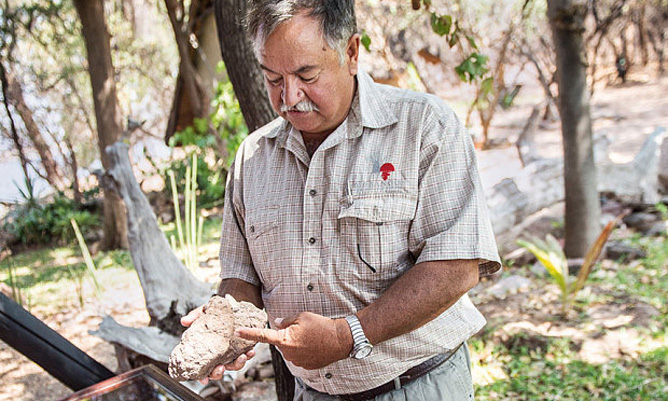
It is 4:30pm on a Thursday in September, and my party is getting crotchety. We have been travelling through the African wilderness since dawn. It is 35˚C outside but, because we are low on fuel, we have turned the air conditioning off, raising temperatures literally and metaphorically. It has not rained for six months, and the scene resembles a set from Badlands: a seemingly never-ending view of fire-blackened earth, leafless trees and sunburnt grass. Tsetse flies are making meals of our sweating flesh. And although we have been travelling through the adjoining Mana Pools National Park, we have not seen a single creature for hours.
The Telegraph
That is not because game is in short supply. Chewore Safari Area is one of Zimbabwe’s best-known hunting concessions, and is renowned for its (fast-disappearing) bull elephants and lions. But like us, we figure, the animals are probably trying to avoid hunters. Besides, we are not here to game-spot, but to visit tracks of creatures that became extinct 65 million years ago: dinosaurs.

Although some significant contributions had been made to the fossil record by such great names, as Geoffrey Bond and Mike Raath, Zimbabwe was not well-known for palaeontological finds. Unlike Kenya and South Africa, where several hominid remains have been found, and Tanzania, where in the early 1900s dozens of dinosaur skeletons were excavated and transported to Berlin, Zimbabwe’s rocks had not yielded much to whet international palaeontological interest. Until 1984, that is, when an Australian hunter, Mike Aldersey, looked down in Chewore and saw prints of a creature far larger than he expected – and three-toed.
Unsure of what they were, he reported them, and when the news filtered back, a geologist from Zimbabwe’s Geological Survey was dispatched. What Tim Broderick and his wife, Patricia, saw, he tells me from his garden in Harare, was “extraordinary”. Sunk into a floor of sandstone were 14 dinosaur prints, “like nothing we had seen before in southern Africa”.
Having made maps of the precise position and size of the prints, in 1990 and 2001, the couple went back with a South African palaeontologist, Prof Theagarten Lingham-Soliar. To date the group has documented more than 100 dinosaur prints in the area, including one trackway incorporating 45 contiguous prints. It is these we have come to find.
Unlike in Tanzania and North America, where museums have been built alongside significant palaeontological finds, in Zimbabwe very few people have seen the prints. They are certainly not easy to spot. If it were not for the hand-drawn maps made by the Brodericks and the Harare-based sedimentologist Ali Ait-Kaci, and a single rusted dinosaur’s spoor sign plonked at a sandy junction, we would have no hope of spotting them.
- Chamisa under fire over US$120K donation
- Mavhunga puts DeMbare into Chibuku quarterfinals
- Pension funds bet on Cabora Bassa oilfields
- Councils defy govt fire tender directive
Keep Reading
In this remote part of Zimbabwe, other than hunters and AK-toting anti-poaching rangers, there is nothing but elephants, buffalo and, we have been warned by Lingham-Soliar, lions, which drooled at him from a clifftop when he was last here.
Having parked on the side of the Ntumbe River, and accompanied by an armed national park ranger, we set off along the wide, dry riverbed. Within a few minutes, a whoop fills the air. Clearly stamped into the grey sandstone are the footprints of what was undoubtedly an enormous prehistoric creature.
About 16in long and 12in wide, each footprint has three toes. We can clearly see that the toes were curved, with joints and claws. From examining the distances between the prints, we can deduce that the beast walked on two legs. And in one spot, where there is an indentation between two parallel prints, we see an indication that it had a balancing tail.
It is almost certain, Lingham-Soliar says, that the beast was an allosaurus: a predecessor to the Tyrannosaurus rex and the dominant carnosaur (or two-legged carnivorous dinosaur) of the late Jurassic age. “Of course, we can’t say for sure, because they are only footprints,” he adds. “But those three toes are very distinctive —almost like giant birds”. The monster’s feet are almost three times the size of mine and, according to Ait-Kaci, it would have stood about 10ft high, with a 40ft-long body. Its most frightening attribute would have been its 40in-long head, featuring two brow horns and large jaws with 4in-long, sharp, serrated teeth.
Most interesting to palaeontologists, though, is evidence that the creatures hunted in packs. Walking further along the riverbed, staying out of the bush to avoid modern-day carnivores, we come to a second set of prints. Like the first set, these were made by a three-toed, bipedal creature. But here there are dozens of prints of varying sizes, some overlapping. “What that shows,” Broderick says, “is not only that they were made at the same time, but that these creatures were working together. The smaller ones indicate that there were probably babies about.”
What the dinosaurs were probably doing, all the experts agree, is hunting. Precisely what they were chasing was a mystery until 2001, when Ait-Kaci made an extraordinary discovery nearby — a single, enormous round dinosaur print. Although we have been given a vague description of the print’s whereabouts, we struggle to locate it. Until, as the sun starts to set, we suddenly spot it: a 35in-wide sunken circle, with four toes — and in a dry stream-bed nearby, seven other similar footprints found later by Patricia Broderick. These giant imprints, Ait-Kaci says, are not just the footprints of an enormous herbivore — probably the brachiosaurus, whose bones have been found farther east in the Zambezi Valley — but the only prints ever found in sub-Saharan Africa of a dinosaur of this kind.
Unlike the carnivorous allosaurus, he explains, this monster was a long-necked, four-legged plant-eater and was gigantic, its 50-tonne body about 98ft long. Its footprints are so big, we note, that if someone small curled up, they could fit inside one.










